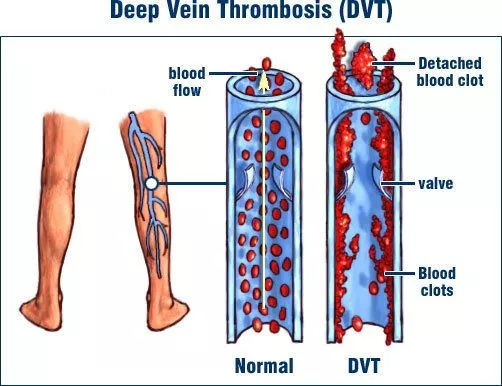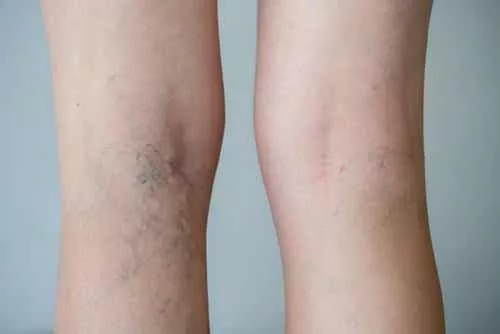What Is Deep Venous Thrombosis?
Contents
Deep venous thrombosis (DVT) is a blood clot in a vein in the body, it is a serious condition, that usually occurs in the legs and pelvis.
Blood clots are needed to stop bleeding, during injury, but they also form when the body doesn’t need them and can lead to stroke.
When blood clots partial or completely block blood flow through the vein, this condition is also called venous thrombosis.
Most blood clots (that may turn into a solid state) occur in the legs, thighs, and pelvis, but why is it a serious case?
Because clots can also travel through the blood to the other body parts and stuck there – for exa – In the lungs, and heart, which leads to serious health issues.
Symptoms
Symptoms typically develop over hours or days, though they can develop suddenly or over a matter of weeks (1) (2).
Here are the most common signs and symptoms of Deep Venous Thrombosis include:
- Pain (on DVT affect area include neck, should, legs, arm (4–10% of DVT occurring in the arms) (3).
- swelling
- fever
- dilaton of surface veins
- redness
- abdominal pain
- mild or severe headache
- tenderness (can occur when you standing or walking)
- pilling sensation
- weakness on hands
- edema
- discoloration on the affected area
Studies have shown that up to 30% of people with DVT don’t see symptoms, however, symptoms sometimes may also be mild.
Blood clot in a vein close to the skin, also known as superficial vein thrombosis, or superficial thrombophlebitis.
How common Is DVT?
It is a life-threatening condition, where blood clots can even move to other body parts, leads serious health concerns.
Also, this condition becomes much more common with age (4), it can occur at any age but is less common in children.
It is 3rd most common vascular disease, behind heart attack and strokes.
A study in India reported a DVT incidence rate ranging from 8% to 20% in major lower limb surgery.
Pictures of Deep venous thrombosis


Reasons & risk factors
DVT is caused by a blood clot (blood clot in veins, and prevents proper blood flow in the body, this may lead to stroke, lung issues, etc.
A blood clot can happen due to many reasons include – injury, certain medicine intake, surgery, etc.
However, there are various risk factors or other reasons that contribute to DVT, including genes and environmental factors.
Risk factors of DVT or blood clots include:
- older age, but can happen at any age
- Injuries including – lower limb amputation, hip, and long bone fractures are also the reason for blood clots (5) (6).
- obesity
- sitting too long
- birth control pill or hormone replacement therapy
- active cancer: blood, lung, pancreas, stomach, bowel, and brain caSee How It Looks Like From Outer Skinncer are allied with a high risk of DVT (7)
- recent surgery
- trauma: Major surgery and trauma increase risk because of tissue factors from outside the vascular system entering the blood (8)
- postpartum period
- smoking
- inflammation disease
- heart failure
- infection (9) including – Covid-19, tuberculosis, sepsis and HIV can also increase the risk.
- antiphospholipid syndrome
- history of VTE
- lack of movement or exercise
- pregnancy
- genes
During pregnancy pressure increases in the veins in the pelvis, increasing the risk of clots, which can even be seen after having a child.
Hormonal replacement therapy increases the risk through, changes in blood coagulation protein levels and reduced fibrinolysis (10)
Genetic factors like – non-O blood type, deficiencies of antithrombin, protein C, and protein S, and mutations in genes are risk factors for it (11) (12).
Test For Deep Venous Thrombosis
Deep Venous Thrombosis (DVT) can also occur without seeing any symptoms.
Signs and symptoms are very helpful to check the likelihood of DVT, but they are not only used to diagnose (13)
The doctor will ask you about your medical history and also do some tests to prove whether it that is really DVT or not, which include:
Ultrasound
Doctors perform ultrasound (a standard imaging test) to confirm or exclude a diagnosis.
Severe Ultrasound methods include – color flow doppler and duplex can be used to further mark the clot (14)
Doppler ultrasound is usually helpful and shows an absence of flow and hyperechogenic content in a clot.
D-dimer test
It is commonly used in clinical to draw a diagnosis of deep vein thrombosis or pulmonary embolism (15).
Also, a high D-dimer indicates an increased risk of abnormal blood clotting.
However, high levels of D-dimer were also found to be related to a higher mortality rate of community-acquired pneumonia (16).
Venography
Imaging tests are still a gold standard test (tests that are the best available under reasonable conditions)
A gold standard test (venography) – injecting a peripheral vein of the affected limb with a contrast agent and taking X-rays (17)
Other tests
- CT scan venography
- MRI venography
Specialists using the wells score (a number that reflects your risk of developing deep vein thrombosis (DVT).
Wells score is categorized into likely and unlikely, where DVT likely is considered is about 28% of chance (18)
Those with a lower score are considered is unlikely to have (Deep Venous Thrombosis) about a 6% chance.
Treatment
As we know that DVT is a life-threatening medical condition, and it is vital to take treatment after a confirmed diagnosis.
Treatment may help prevent a pulmonary embolism and reduce the risk of having blood clots.
Blood-thinning medicines
Patients may inject with anticoagulant a (blood thinning) medicine (19)
BT medicine makes it hard for blood to clot and also keeps existing clots as small as possible which decreases the risk of developing more clots.
Treatment varies depending on the location of DVT such as – In the case of isolated distal DVT, ultrasound might be used instead of an anticoagulant.
Some other oral medications that are sufficient to take it oral include:
- Rivaroxaban
- apixaban
- aspirin can be used to reduce recurrent VTE
Graduated compression stockings
In this apply higher pressure at the ankles and lower pressure around the knees to manage acute DVT symptoms.
However, they are not recommended for reducing the risk of post-thrombotic syndrome (20).
The doctor may recommend you wear these every day, which can also likely reduce VTE recurrence (21)
Surgery
The doctor may suggest surgery, which is only recommended when large blood vessels clot that causing a serious issue
Surgery may also have some risks which include:
- infection
- damage to the blood vessels
- excess bleeding
IVC filter
Inferior vena cava filter includes – inserting a (lotus-type equipment) inside the large abdominal vein called vein cave.
The filter also has some cons, if they are left in for too long, it should only be used for a short-term period (22).
A 2018 study found that IVC filter placement leads to a 50% reduction in PE, a 70% increase in DVT, and an 18% increase in 30-day mortality than non-IVC.
Complications
The most common long-term complication is a post-thrombotic syndrome, which can lead to other health issues including:
- Chronic pain
- feeling heaviness in the chest can result from various mental and physical health conditions
- itching
- ulcers in leg
- an abnormal sensation of skin
Talk to your doctor if you see these signs of pulmonary embolism. these signs include:
- swelling
- dizziness
- blood in coughing
- chest pain
- rapid heart rate or breathing
- sweating
NOTE: – Food And Drinks That Related To Excessive Sweating
Studies have shown that after proximal DVT, about 20–50% of people develop the syndrome, with 5–10% facing severe symptoms.
Superior vena cava syndrome is also a complication of arm DVT, however, it is a rare condition.
How Can We Prevent It?
You can lower your risk of having DVT by making a few healthy lifestyles including:
- Leg exercise
- manage blood pressure
- avoid smoking
- maintain a healthy weight
- keep active, with daily home activity, and exercise, like walking, running, etc
- do not drink lots of alcohol
- keep yourself hydrated, because DVT is more likely to occur if you are dehydrated
A person who sits for too long is more at risk of it, so avoid sitting too long, which can lead to heart disease, laziness, and short life.
You can prevent too much sitting by taking a break after every 30 minutes, walking, using the stairs, joining active games, etc.
Walking increases blood flow through the leg veins (23) and also reduces weight which is most common risk factor of DVT (24).
DVT and Pregnant Women
Pregnant women are 4 to 5x times more at risk of developing DVT, compare to non-pregnant women (25).
Your baby weight creates pressure on blood vessels around your legs, and pelvis, which reduces blood flow, and causes blood clots.
During pregnancy blood clots can also cause:
- Heart attack
- miscarriage
- stroke
- stillbirth
- premature birth
- interact with baby growth
While pregnant, the level of blood-clotting proteins increases and the level of anticlotting proteins falls.
C-section surgery also increases the risk of DVT, however, this risk can still stay about 6 weeks after the birth child.
NOTE: – Monkeypox And Pregnancy: Relation, Symptoms, Risk, And More
DVT and Travelers
Traveling “is an often cited yet relatively uncommon” cause of VTE (26).
When you fly high you are more develop blood clots, because as we know that sitting for a long-time can cause DVT.
Travelers can reduce the risk by doing these ways include:
- Calf exercises
- frequent walking on airplanes (27)
- compression stocking
- sit in an exit row so you have more leg space to stretch
Check Out – Positive Health Benefits of Going To Adventure Ride
Down Line
DVT is a serious health condition, that affects pregnant women, older people, long-sitting people, etc.
Blood clots in arms, and legs, can even move to other body parts, like in lungs, and heart leads serious health concerns.
However, the doctor mostly recommends you prescribed blood-thinning medicines, stockings, etc.
Avoid sitting too long, keep yourself active, consume rich fiber, fruits, and vegetables, keep you hydrated, etc.


